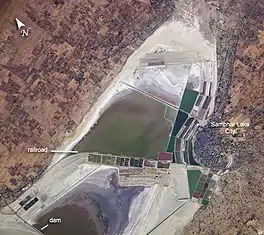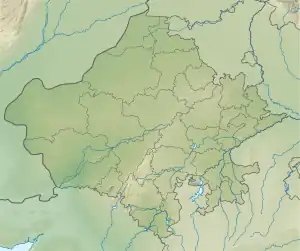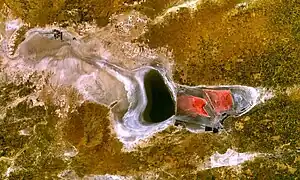| Sambhar Lake | |
|---|---|
 Aerial view of Sambhar Lake in Jaipur district (RJ) | |
 Sambhar Lake  Sambhar Lake | |
| Location | Sambhar Lake Town, Jaipur district, Rajasthan, India |
| Coordinates | 26°56′30″N 75°04′35″E / 26.94167°N 75.07639°E |
| Type | Salt lake |
| Primary outflows | Luni River |
| Catchment area | 5,700 km2 (2,200 sq mi) |
| Basin countries | |
| Designation | Ramsar Site |
| Max. length | 35.5 km (22.1 mi) |
| Max. width | 3 to 11 km (1.9 to 6.8 mi) |
| Surface area | 190 to 2,300 km2 (73 to 888 sq mi) |
| Average depth | 0.6 to 3 m (2.0 to 9.8 ft) |
| Max. depth | 3 m (9.8 ft) |
| Surface elevation | 360 m (1,180 ft) |
| Designated | 23 March 1990 |
| Reference no. | 464[1] |
The Sambhar Salt Lake, India's largest inland salt lake, is located in Sambhar Lake Town, Jaipur district of Rajasthan, India, 80 km (50 mi) southwest of the city of Jaipur and 64 km (40 mi) northeast of Ajmer, Rajasthan. It surrounds the historical Sambhar Lake Town.
Geography

The lake receives water from six rivers: Mantha, Rupangarh, Khari, Khandela, Medtha and Samod. Lake has 5700 square km catchment area.[2] The lake is an extensive saline wetland, with water depth fluctuating from as few as 60 centimetres (24 in) during the dry season to about 3 meters (10 ft) at the end of the monsoon season. It occupies an area of 190 to 230 square kilometers based on the season. The lake is elliptically shaped with a length of approximately 35.5 km and a breadth varying between 3 km and 11 km. The lake straddles Nagaur and Jaipur districts and borders on the Ajmer district. The circumference of the lake is 96 km, and it is surrounded by the Aravali hills on all sides.
The Sambhar lake basin is divided by a 5.1 km long dam made of sandstone. After the saltwater reaches a certain concentration, it is released from the west side to the east side by lifting dam gates. To the east of the dam are salt evaporation ponds where salt has been farmed for a thousand years. This eastern area is 80 square km and comprises salt reservoirs, canals and salt pans separated by narrow ridges. To the east of the dam is a railroad, built by the British (before India's independence) to provide access from Sambhar Lake City to the salt works.
The water is fed into the lake from streams from the rivers Mendha, Runpangarh, Khandel, and Karian. The Mendha and Rupangarh are main streams. The Mendha flows from north to south and the Rupangarh flows from south to north.
The temperature reaches 45 °C (113 °F) in summer and goes as low as 5 °C (41 °F) in winter.
Economic importance
Sambhar Salt Lake is India's largest saline lake and is the source of most of Rajasthan's salt production. It produces 196,000 tonnes of clean salt every year, which is around 9% of India's salt production. Salt is produced by evaporation of brine and is mostly managed by the government-owned company - Sambhar Salts Ltd.(SSL), a joint venture of the Hindustan Salts Ltd.[3] and the state government. SSL owns 3% of the eastern lake.
The company is struggling to produce sufficient amount of salt but the private players are producing more than 10 times that of the company due to production from thousands of illegal borewells, which are also severely harming the ecology of the salt lake.[4] (see Environmental concerns section)
There are 38 clusters of villages surrounding the lake. Major settlements include Sambhar, Gudha, Jabdinagar, Nawa, Jhak, Korsina, Jhapok, Kanseda, Kuni, Tyoda, Govindi, Nandha, Sinodiya, Arwik ki dhani, Khanadja, Khakharki, Kerwa ki dhani, Rajas, Jalwali ki dhani.
In 2014, six PSUs including Bharat Heavy Electricals Limited and Power Grid Corporation of India Ltd had planned to set up the world's largest 4,000 MW Ultra-mega Solar power project in the land under the company.[5] But after BJP government came to power in the state, the project was scrapped, citing environmental issues and shifted to Gujarat.[6]
In 2019, the Rajasthan government started an asset-liability assessment to take over loss-making Sambhar Salts Ltd. from Hindustan Salts Ltd.[7]
Ecological importance
Sambhar has been designated as a Ramsar site (recognized wetland of international importance) because the wetland is a key wintering area for tens of thousands of pink flamingos and other birds that migrate from northern Asia and Siberia. The specialized algae and bacteria growing in the lake provide striking water colours and support the lake ecology that, in turn, sustains the migrating waterfowl. There is other wildlife in the nearby forests, where Nilgai move freely along with deer and foxes. (see Environmental concerns section)
In November 2019, nearly 20,000 of migratory birds were found dead mysteriously in the lake area.
The salt (NaCl) concentration in this lake water differs from season to season. The salt concentration in the pans (kyars) varies and, accordingly, the color of the brine ranges from green, orange, pink, purple, pink and red due to the bloom of haloalkaliphilic microorganisms. The first haloalkaliphilic archaeon isolated from this lake was Natrilaba SSL1 (earlier designated as Natronobacterium SSL1 ATCC 43988 by Upasani and Desai (1990). More recently, haloalkaliphilic microalgae namely Dunaliella, Euhalothece, Nitzchia, etc. have also been isolated (Bhatt H. H.and Upasani V. N., 2016). The archaeal isolates can be a source of haloalkaliphilic enzymes for biotechnological applications.
History and tourism
The Indian epic Mahabharata mentions the Sambhar Lake as a part of the kingdom of the demon king Vrishparva, as the place where his priest Shukracharya lived, and as the place where the wedding between his daughter, Devayani, and King Yayati took place. A temple near the lake is dedicated to Devayani.
The legend has it that Shakambhari Devi, the tutelary goddess of Chauhan (Prithviraj Chauhan) and the consort of Lord Shiva, converted a dense forest into a plain of silver as payment for some service. Subsequently, at the request of the inhabitants who dreaded the greed and strife that such a possession would beget, she transformed the silver plain into a lake. The name of the lake, Sambhar, stems from a variation Shakambhari, which happened around the sixth century.[8] Another temple near the lakeshore is dedicated to Shakambhari Devi.
In 1884, ancient sculpture art was discovered in the area as part of small-scale excavation work done in Sambhar Lake. During that excavation, some terracotta structures, coins, and seals were found along with a clay stupa. Sambhar sculpture art appears to be influenced by Buddhism. Later on, around 1934, a large-scale systematic and scientific excavation was conducted in which a large number of terracotta figurines, stoneware, and decorated discs were found. A number of these sculptures from Sambhar are present at the Albert Hall Museum.
Tourism and filming destination
For the film Delhi-6 directed by Rakeysh Omprakash Mehra, production designer Samir Chanda recreated inner lanes of Old Delhi at Sambhar. Later for certain scenes, historic Jama Masjid was digitally added to the frame as a backdrop. Certain scenes of many other popular films have been shot around the lake and the main Sambhar Lake Town such as:
- Delhi-6
- Veer
- Gulaal
- Highway
- Drona
- Zila Ghaziabad
- PK
- Tevar
- Goliyon Ki Raasleela Ram-Leela
- Super 30
- Bard of Blood
Songs shot:
- DJ Wale Babu, "She move it like" - Badshah
- "Car Me Music Baja" - Neha Kakkar
- "Mar Gaye Meet Gaye Lut Gaye" - Hans Raj Hans
- "Lahore, Surma Surma" - Guru Randhawa
On the 68th Republic Day of the India, Nissan GT-R set a world record in Limca Book of Records by making the largest outline of the map of India. It recreated the approximate outline of Indian map spanning 3 km in length and 2.8 km in width with a total outline periphery of 14.7 km at Sambhar Lake.[9]
Transport
The nearest airports are Jaipur International Airport and Kishangarh Airport
Commute through public transport: Sambhar Lake Town railway station, Phulera Junction railway station and RSRTC[10] bus stand.
Environmental concerns
- Rajasthan government confirms botulism killed thousands of birds at Sambhar Lake in Jaipur - INDIA TODAY; https://www.indiatoday.in/india/story/rajasthan-government-confirms-botulism-killed-thousands-birds-sambhar-lake-jaipur-1621522-2019-11-22
- सांभरझील और उसके संरक्षण से जुड़े कुछ पहलु by Dau Lal Bohra. https://rajasthanbiodiversity.org/sambhar-lake-salt-extraction-migratory-birds/
- Ideas for Cause Pile up but Mystery of Avian Horror at Sambhar Lake Persists https://thewire.in/environment/sambhar-lake-bird-death-avian-influenza-botulism-salt-mining-electrocution
- सांभर झील पर सुबह उड़ा ड्रोन, पक्षियों की तलाश शुरू - राजस्थान पत्रिका https://www.patrika.com/jaipur-news/drones-flew-on-sambhar-lake-in-the-morning-birds-started-searching-5401454/
- Sambhar Lake: 18 हजार पक्षियों की मौत के बाद सांभर झील से नमक सप्लाई पर रोक, एनजीटी ने मांगी रिपोर्ट - दैनिक जागरण; https://www.jagran.com/rajasthan/jaipur-ban-on-salt-supply-from-sambhar-lake-after-the-death-of-18-thousand-birds-19779644.html
- Sambhar lake, the death bed for thousands of birds - THE FREE PRESS JOURNAL; https://www.freepressjournal.in/india/sambhar-lake-the-death-bed-for-thousands-of-birds
- राजस्थान की सांभर झील बनी कब्रगाह, 18 हजार पक्षियों की मौत - दैनिक जागरण; https://www.jagran.com/rajasthan/jaipur-18-thousand-birds-found-dead-in-sambhar-lake-of-rajasthan-19771398.html
- Management, hydrology, salt pans — What's behind Rajasthan's bird crisis? - THE INDIAN EXPRESS; https://indianexpress.com/article/explained/sambhar-lake-rajasthan-bird-deaths-in-india-6129271/
- Illegal salt mining under scanner for mass death of birds at Rajasthan's Sambhar Lake - THE PRINT; https://theprint.in/environment/illegal-salt-mining-under-scanner-for-mass-death-of-birds-at-rajasthans-sambhar-lake/321869/
- Avian botulism: Deadly disease kills thousands of birds in Rajasthan's Sambhar Lake - THE HINDU; https://www.thehindu.com/sci-tech/energy-and-environment/avian-botulism-kills-thousands-of-birds-in-rajasthans-sambhar-lake/article30049110.ece
- Cancel illegal salt pans in Sambhar Lake: NGT bench to Rajasthan government - INDIAN EXPRESS; https://indianexpress.com/article/india/cancel-illegal-salt-pans-in-sambhar-lakengt-bench-to-raj-govt-4422187/
- Thousands of migratory birds die mysteriously in Rajasthan's Sambhar Lake; https://www.thehindu.com/news/national/other-states/thousands-of-migratory-birds-die-mysteriously-in-rajasthans-sambhar-lake/article29950537.ece/amp/
- Migratory birds retreat from a 'shrinking' Sambhar Lake : study - TIMES OF INDIA; https://timesofindia.indiatimes.com/city/jaipur/migratory-birds-retreat-from-a-shrinking-sambhar-lake-study/articleshow/67506709.cms
- Public Interest Litigation (PIL) No. 108 of 2013 filed by Naresh Kadyan at the SUPREME COURT of INDIA about bore well mafia, illegal encroachments around Sambhar lake - Wetland of Rajasthan - SCRIBD.COM; https://www.scribd.com/doc/128383352/PIL-for-Sambhar-lake-moved-by-Naresh-Kadyan-before-Supreme-Court-of-India
- Choked on salt - DOWN TO EARTH; https://www.downtoearth.org.in/news/choked-on-salt-41030ref=true
- Sambhar - a lake no more; TIMES OF INDIA https://timesofindia.indiatimes.com/city/jaipur/sambhar-a-lake-no-more/articleshow/62552440.cms
- Sambhar lake - INDIA's largest inland source inland salt being slowly killed; INDIA TODAY; https://www.indiatoday.in/magazine/environment/story/19990308-sambhar-lake-indias-largest-inland-source-of-salt-being-slowly-killed-780335-1999-03-08
- Is it worth the salt ? - EXCAVATE.COM; https://www.excavate.in/indiawaterportal-is-it-worth-the-salt/
- सांभर का नमक मांग रहा अब अपना हक - पत्रिका; https://www.patrika.com/bagru-1/sambhar-demanding-right-of-salt-production-in-rajasthan-election-3778155/
- Private players illegally edge out government-owned Sambhar Salts in salt production - ECONOMIC TIMES; https://economictimes.indiatimes.com/news/economy/finance/private-players-illegally-edge-out-government-owned-sambhar-salts-in-salt-production/articleshow/50909841.cms
- A salty sore: the dying sambhar lake - INDIA WATERPORTAL; https://www.indiawaterportal.org/news/salty-sore-dying-sambhar-lake
- Reality check: Sambhar Lake may cease to exist in few years - DNA ; https://www.dnaindia.com/jaipur/report-reality-check-sambhar-lake-may-cease-to-exist-in-few-years-2609744
- Ban On Pan-well Making At Sambhar Lake - THE INDIAN SALT MANUFACTURERS ASSOCIATION ; http://www.indiansaltisma.com/news-detail/7/ban-on-pan-well-making-at-sambhar-lake
- Arrival of Lesser Flamingos declines at Sambhar Lake - THE HINDU ; https://www.thehindu.com/news/national/arrival-of-lesser-flamingos-declines-at-sambhar-lake/article6797259.ece
- "Ashok Kumar Jain, "Conservation Planning of Sambhar Lake, Rajasthan using Satellite Remote Sensing and GIS", Andhra University thesis (2005). Indian Institute of Remote Sensing" (PDF). Archived from the original (PDF) on 9 August 2011. Retrieved 6 January 2008. 5.10 MiB
References
- ↑ "Sambhar Lake". Ramsar Sites Information Service. Archived from the original on 10 May 2018. Retrieved 25 April 2018.
- ↑ "River basins with Major and medium dams & barrages location map in India, WRIS". Retrieved 10 May 2014.
- ↑ Hindustan Salts Ltd.
- ↑ Narayanan, Dinesh (9 February 2016). "Private players illegally edge out government-owned Sambhar Salts in salt production". The Economic Times.
- ↑ Rajasthan to have world's largest solar power project
- ↑ Rajasthan mega solar project likely to be shifted to Gujarat
- ↑ State govt set to take over Sambhar Salts from centre
- ↑ "The Imperial Gazetteer of India VOL XXII". Oxford At The Clarendon Press. 1908.
- ↑ Largest map outline
- ↑ "RSRTC Ticket Booking". RSRTC Ticket Booking. Retrieved 14 December 2020.